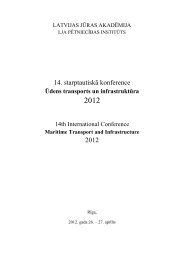You also want an ePaper? Increase the reach of your titles
YUMPU automatically turns print PDFs into web optimized ePapers that Google loves.
1. The aim of research and methodological approachImportance of maritime education system depends on its capacity to supply maritime industry withpeople meeting industry needs. <strong>Maritime</strong> education is economically viable only if sufficient demand (orcritical mass) exists due to large fixed costs, but once in-place it can service a large number and widerange of actors [7]. Not only seafarers can be educated in maritime training institutions but also portpersonnel and others whose employment and therefore educational background is linked with ships,shipping etc. The demand for seafarers’ maritime education can be viewed as international even if it isrelated to demand for seafarers of particular country as the education system is local and in line withcountries’ education system. As the maritime education supplies local and global seafarers’ pool at thesame time it is important to determine factors which are linked with maritime education system andinfluences graduates in the seafarers’ pool. Science Direct and Springer Link databases was used forsearching of articles related to this issue, however, the articles which combine detailed information aboutseafarers’ employment and their educational background were not presented. The databases containarticles which discuss the shortage of seafarers and factors influencing the supply and demand ofseafarers labour. For example: “Crew study of seafarers: a methodological approach to the global labourmarket for seafarers” written by Bin Wu and Nik Winchester [8] discusses the context of the complexityof the global labour market for seafarer. The authors of the article propose the crew study of seafarers(CSS) as a mean to access, analyse and compare information on active seafarers world-wide. However,crew lists which serve as main source for input data used in analysis doesn’t reflect seafarers’ educationalbackground. Other articles such as „Employment of seafarers in the EU context: Challenges andopportunities” [6] explore challenges that can be seen to have a negative effect on the employment of EUseafarers and examine forces that can be regarded as opportunities for the seafaring profession in the EU.However, those forces are described in general focussing on qualitative not quantitative aspects. In article„A method for estimating world maritime employment” written by Li and Wonham [9] authorsestablishes a method to estimate maritime labour worldwide. Even this article tackles the issues of thepool of seafarers it doesn’t discuss the contribution of maritime education and capability of maritimesystem to supply labour required on ships. Looking at the articles related to the maritime education itwasn’t possible to find articles where the role of maritime education is analysed in quantitative aspects forcontext of supply side of maritime labour. It can be assumed that even if such researches exist they arenot easily accessible and specific search methods should be applied to find them.Looking at the methods utilised in previously mentioned researches it can be seen thatmethodological approaches and data sources used in those researches are not suitable for analysing twodifferent blocks such as pool of active seafarers and education system even if the links between them existand have major importance. In most cases the primary data source is provided by different kinds ofsurveys, therefore the researches which use published results of surveys or researches are based onsecondary data sources. For example, survey to collect necessary data is used in cluster analysis of themaritime sector in Norway [7] or in determination of land-based jobs for ex-seafarers in UK [10]. Otherway to get access to primary source is to use questionnaires. This approach is linked with particularqualitative aspects and for example was used in 1996 for ITF (International Transport Worker’sFederation) questionnaire survey of seafarers with aim to get information about all aspects of seafarersworking lives [11]. These approaches don’t allow drawing direct links between maritime educationsystem and seafarers’ pool. Therefore micro data analysis is required to overcome problem ofaccessibility of data. For example, this approach was used for inflow-outflow analysis of labour inDanish maritime cluster [12]. The database containing information about employment of particularpersons is prerequisite to get such a micro data. However, access to such a registers often is limited asusually they contain sensitive information about persons included in database.Seamen Registry of <strong>Latvian</strong> <strong>Maritime</strong> Administration maintain seafarers’ database of <strong>Latvian</strong>seafarers with entries about the seafarers their education, qualification, seagoing services and other datarequired for certification according requirements of STCW Convention. Although the main purpose ofdatabase is to serve for certification of seafarers it gives possibility (by analysing content of it) to look onthe historical development of seafarers’ education and training system in Latvia.The main aim of this research is the determination of the contribution parameters and their values ofmaritime education system in Latvia. This aim is achieved by using micro data analysis of seafarers’education and employment. The micro data analysis covers information about all seafarers included indatabase and is a combination of 280 000 entries about employment with 23 000 entries about education.Combining of the data sets individual persons were separated and group of 11 000 people where extracted5
















